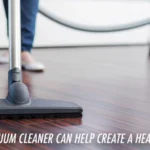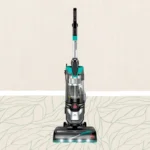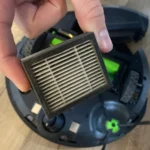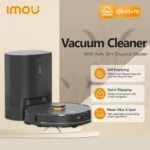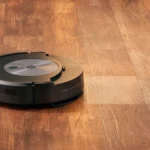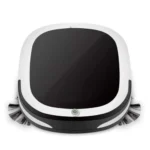As much as we love our smart vacuum cleaners, our furry friends might not feel the same way. Does your pet run for the hills every time you turn on your trusty cleaning companion? It’s not uncommon for pets to be afraid of smart vacuum cleaners, but that doesn’t mean it’s something you have to accept. In this article, we’ll explore why smart vacuum cleaners can be scary for pets, the signs to look out for, and most importantly, how to help your pet overcome their fear step-by-step. So let’s dive in and make sure your pet is no longer scared of your smart vacuum cleaner!
Why Smart Vacuum Cleaners Scare Our Pets

Our furry friends have a keen sense of hearing, smell, and sight. That’s why many smart vacuum cleaners with their high-pitched noise and unusual appearance can cause distress and fear in our pets. The harsh, mechanical sounds and sudden movements of a cleaning robot can make our dogs and cats feel threatened and anxious, as if they are facing a predator. To understand better why smart vacuum cleaners scare our pets, let’s take a closer look at some of the main reasons why they might be spooked. Perhaps you also made some mistakes while trying to calm down your pet during the cleaning process. Check out this article on 5 Common Mistakes Pet Owners Make while Using Smart Vacuums to reduce your fuzzball’s fear and stress levels.
Noise and Sound Frequency
When it comes to smart vacuum cleaners, one of the main reasons why they scare our pets is the noise and sound frequency they produce. The loud and unusual noises produced by the vacuum can cause anxiety and fear in our furry friends. Additionally, the frequency of the sound can add to their discomfort, as dogs and cats can perceive high-pitched sounds that humans can’t.
To help your pet overcome fear of a smart vacuum cleaner, it’s important to understand their sensitivity to sound frequency. Here are some specific noise-related factors to consider:
- Tone: Dogs and cats can perceive higher frequencies than humans, so the sound of the vacuum cleaner can sound more intense and high-pitched to them.
- Volume: The sound produced by a smart vacuum cleaner can be very loud, as most models are designed to clean large spaces. Keeping the volume down and using quieter models can help alleviate some of your pet’s anxiety.
- Type of sound: Some pets may react negatively to certain types of sounds produced by the vacuum cleaner. For example, the beep or chime that signals the end of a cleaning cycle may startle or scare your pet.
It’s important to note that every pet is different and may react to noise in their own way. Some may be more sensitive to loud sounds or high-pitched frequencies, while others may be bothered by certain types of sounds. It’s important to observe your pet’s behavior and reactions to the vacuum cleaner to understand what is causing their fear.
In the next section, we will explore the movement and shape of smart vacuum cleaners and how they can also contribute to your pet’s fear. Pet smart vacuum training can be a helpful step to take to ensure your pet feels comfortable at home.
Movement and Shape
When it comes to why smart vacuum cleaners scare our pets, movement and shape are another major factor. Smart vacuums may move quickly and abruptly, changing directions without warning or making sudden turns. Additionally, the shape may be unusual for pets since they are used to seeing their owners holding regular vacuum cleaners.
To a dog or cat, the sight of a smart vacuum cleaner moving on its own, sometimes in a random or unpredictable pattern, can be incredibly unsettling. Pets may perceive the vacuum cleaner as a potential threat or predator due to its odd shape and erratic movements.
As a result, it’s essential to help your pet understand that the smart vacuum is not a threat and won’t cause harm. Gradual exposure can help pets become more familiar with the vacuum’s shape and movements over time. This can be done by introducing it slowly, in a non-threatening way, until your pet is comfortable enough to approach it on their own.
Incorporating positive reinforcement can also make a big difference in helping your pet overcome their fear of smart vacuum cleaners. For example, you can offer treats or toys each time your pet investigates the vacuum, helping them form positive associations with the device.
By taking steps to help your pet feel more comfortable around smart vacuums, you can help ease their fear and prevent negative behaviors from developing in response. It’s also important to maintain a consistent vacuuming routine, keep the vacuum in good working condition, and seek help from professionals as needed to ensure your pet can live comfortably in your home. For more information, check out our article on pet smart vacuum training or pet calm vacuum cleaning.
Signs Your Pet is Scared of Your Smart Vacuum Cleaner

Do you suspect that your furry friend is afraid of your smart vacuum cleaner, but you’re not sure? Pets can’t communicate their fear like humans do, which can sometimes make it difficult to tell if they’re spooked by something in their environment. Fortunately, there are some telltale signs to watch out for that can indicate your pet is scared of the smart vacuum cleaner. By recognizing these signs, you can take steps to help your pet overcome their fear and feel more comfortable in their home.
Physical Reactions
Pets express their fear in various ways, and it is important to recognize the physical reactions of your pet when they encounter a smart vacuum cleaner. The following table outlines some common physical reactions your pet might display:
| Physical Reaction | Description |
|---|---|
| Trembling or shaking | This is a common physical reaction, and it usually indicates that your pet is very scared or anxious. |
| Hiding or running away | If your pet is afraid of your smart vacuum cleaner, they might try to hide or run away from it. |
| Pacing or restlessness | Some pets might pace back and forth or become restless when they are scared. |
| Panting or rapid breathing | If your pet is scared, they might start panting or breathing rapidly. This is often a sign of anxiety or stress. |
| Whining or yowling | Some pets might vocalize their fear and start whining or yowling when they see or hear the smart vacuum cleaner. |
| Dilated pupils | If your pet’s pupils become dilated or enlarged, it might be an indication that they are fearful or stressed. |
It’s important to note that these reactions might occur together or separately, depending on your pet’s personality and the severity of their fear. If you notice any of these physical reactions from your pet, it’s essential to try and calm them down and make them feel more comfortable.
Behavioral Changes
As a pet owner, it’s important to pay attention to your furry friend’s behavioral changes when it comes to your smart vacuum cleaner. Here are some signs that your pet may be scared of the device:
| Behavioral Changes |
|---|
| Avoidance: Your pet may try to escape the room or get out of the house altogether when they see or hear the vacuum cleaner. |
| Aggression: Your pet may become aggressive towards the vacuum cleaner or even towards you when you’re using it. This can be a sign that they feel threatened or territorial. |
| Anxiety: Your pet may become anxious and display signs of distress when the vacuum cleaner is in use. This can include panting, pacing, and drooling. |
| Excessive barking: If your pet is barking more than usual when the vacuum cleaner is turned on, it could be a sign that they are scared. |
| Uncharacteristic hiding: Your pet may hide in unusual spots or under furniture, which can be a sign that they feel unsafe or threatened. |
If you notice any of these behavioral changes, it’s important to take steps to help your pet feel safe and comfortable around your smart vacuum cleaner. This may require some patience and persistence on your part, but the effort will be worth it when you have a happier, more relaxed pet.
How to Help Your Pet Feel More Comfortable Around a Smart Vacuum Cleaner
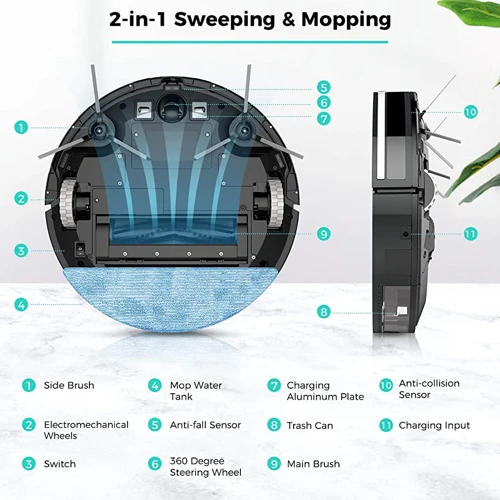
Now that you understand why your pet may be fearful of your smart vacuum cleaner, it’s important to know what steps you can take to help them overcome their fears. Improving your pet’s comfort level around the vacuum cleaner will not only reduce their anxiety, but it will also make vacuuming a much easier task for you. So, let’s dive into some helpful techniques that will help your furry friend feel more at ease.
Gradual Exposure
Gradual exposure is crucial when it comes to helping your pet overcome fear of a smart vacuum cleaner. It involves introducing your pet to the vacuum cleaner slowly and gradually, so they can get used to it. Here’s a table outlining the steps for successful gradual exposure:
| Step | Action |
|---|---|
| Step 1 | Place the smart vacuum cleaner in a room where your pet is not present and turn it on. Let your pet sniff around the vacuum cleaner while it is off to get used to its shape and size. |
| Step 2 | After your pet has had some time to get used to the vacuum cleaner, turn it on but keep it in a stationary position. Let your pet hear its sound without it moving. |
| Step 3 | Gradually increase the amount of time the vacuum cleaner is on while stationary. Reward your pet with treats and praise for staying calm. |
| Step 4 | Once your pet is comfortable with the vacuum cleaner being on while stationary, start moving it around the room slowly. Reward your pet for staying calm. |
| Step 5 | Gradually increase the speed and duration of the vacuum cleaner’s movement while rewarding your pet for staying calm. |
| Step 6 | Finally, vacuum a small area while your pet is present in the room. Start with a room far away from your pet’s safe place and keep the vacuum cleaner away from your pet at first. As your pet adjusts, bring the vacuum cleaner closer. Reward your pet with treats and praise for staying calm. |
Remember to take your time and not rush through the steps. Each pet is different and may require more or less time to acclimate to the vacuum cleaner. Also, do not forget to offer treats and encouragement along the way. By gradually exposing your pet to the smart vacuum cleaner, you can help them overcome their fear and be more comfortable around it.
Positive Associations
One effective way to help your pet feel more comfortable around your smart vacuum cleaner is to create positive associations with the device. This means that you will need to teach your pet to associate the vacuum cleaner with something positive, such as treats or playtime.
To do this, start by placing the vacuum cleaner in a location where your pet can see it from a distance. Next, take out your pet’s favorite treats or toys and play with them near the vacuum cleaner. As you offer your pet treats or engage in playtime with them, gradually move the treats or toys closer to the vacuum cleaner.
Over time, your pet will start to associate the smart vacuum cleaner with positive experiences and will begin to feel more comfortable around it. This type of positive reinforcement can help to reduce your pet’s fear and anxiety around the device.
Here are some additional tips for creating positive associations with your smart vacuum cleaner:
- Use a calming scent: Consider using essential oils or scents that have a calming effect on your pet, such as lavender or chamomile.
- Play relaxing music: Soft, calming music can also help to soothe your pet’s nerves and make them feel more relaxed around the vacuum cleaner.
- Practice regularly: It’s important to practice these positive associations on a regular basis to reinforce the positive connection between your pet and the vacuum cleaner.
By using positive reinforcement techniques, you can slowly teach your pet that the smart vacuum cleaner is not something to be feared. As your pet becomes more comfortable around the device, they will be less likely to exhibit signs of fear or anxiety when you use it around them.
Use Pet-Friendly Gadgets
You can use pet-friendly gadgets to help your furry friend overcome fear of your smart vacuum cleaner. These gadgets provide a sense of comfort and security to your pet and make them feel less stressed in the presence of the vacuum cleaner.
Here are some pet-friendly gadgets that you can use:
- Calming Collars: These collars emit a soothing scent that helps reduce anxiety and promote relaxation in pets. The calming scent released by these collars can help to reduce your pet’s fear of the vacuum cleaner and create a positive association with it.
- Anxiety Wraps: Anxiety wraps like Thundershirts provide gentle pressure to your pet’s body, which has a calming effect on them. These wraps can help your pet feel less scared of the vacuum and reduce their anxiety levels when it is turned on.
- Distracting Toys: Providing your pet with a fun and interactive toy can help to distract them from the noise and movement of the vacuum cleaner. Toys like puzzle feeders or chew toys keep your pet occupied and engaged, redirecting their attention away from the vacuum cleaner.
- Sound Therapy: You can also use sound therapy to help your pet relax in the presence of the vacuum cleaner. Products like iCalmPet provide calming music and sounds that can help reduce your pet’s stress levels and create a positive association with the vacuum cleaner.
Using pet-friendly gadgets in combination with gradual exposure and positive reinforcement can be highly effective in helping your pet overcome their fear of a smart vacuum cleaner. Keep in mind that every pet is different, and what works for one may not work for another. Experiment with different gadgets and techniques until you find the best approach for your furry friend.
Additional Tips
As much as we all love our furry companions, helping them overcome their fear of smart vacuum cleaners may require a bit of extra effort. Along with the gradual exposure and positive associations we discussed earlier, there are some additional tips that can make the process smoother and more effective. The following suggestions will help you maintain a consistent vacuuming routine, ensure that the vacuum cleaner is in good working condition, involve a professional trainer or veterinarian if necessary, and most importantly, be patient and offer plenty of treats and encouragement along the way. Let’s dive in and explore these tips further.
Maintain a Consistent Vacuuming Routine
One way to help your pet overcome their fear of a smart vacuum cleaner is to maintain a consistent vacuuming routine. This may sound counter-intuitive, but it can actually help your pet become desensitized to the presence of the vacuum cleaner over time.
Consistently vacuuming the same areas of your home (such as high-traffic areas or spots where your pet spends a lot of time) can help your pet become accustomed to the sound and movement of the vacuum cleaner. This will be especially helpful if your pet is triggered by sudden changes or unfamiliar stimuli in their environment.
Here are some tips for maintaining a consistent vacuuming routine:
- Set a regular schedule for vacuuming and stick to it as closely as possible
- Start with brief vacuuming sessions and gradually increase the duration over time
- Use a low noise setting on your vacuum cleaner if possible
- Focus on areas away from your pet at first, and gradually move closer over time
- Avoid sudden movements or surprises while vacuuming around your pet
By maintaining a consistent vacuuming routine, you can help your pet feel more comfortable and familiar with the sound and sight of the vacuum cleaner. This can ultimately lead to a reduction in fear and anxiety around this common household appliance. Remember to take things slow and be patient with your furry friend – overcoming fears takes time and effort, but it’s worth it to see your pet happy and relaxed in their home.
Make Sure the Vacuum Cleaner is in Good Working Condition
It’s crucial to ensure that your smart vacuum cleaner is in good working condition if you want to help your pet overcome their fear of it. Before introducing your pet to the vacuum, follow these steps to ensure that it’s working correctly:
- Check the power cord: Make sure that the power cord is not damaged or frayed. If it is, unplug the vacuum and replace the cord before using it.
- Inspect the brushes: Check the vacuum’s brushes to make sure that they’re clean and free of debris. Dirty brushes can clog the vacuum and cause it to malfunction.
- Empty the dustbin: If your smart vacuum cleaner has a dustbin, make sure to empty it before use. A full dustbin can cause the vacuum to lose suction, which can make it louder and more startling for your pet.
- Test the suction: Turn on the vacuum in an empty room and check that it’s suctioning normally. This will also give your pet a chance to get used to the sound and movement of the vacuum before introducing it to them.
It’s important to keep in mind that a malfunctioning vacuum can make loud, unexpected noises or movements that can startle your pet and reinforce their fear of it. By ensuring that your vacuum is in good working condition, you’ll be able to provide a more predictable and controlled environment for your pet when introducing them to the vacuum.
Involve a Professional Trainer or Veterinarian
When all else fails and your efforts seem to be ineffective, it’s time to involve a professional trainer or veterinarian. A professional trainer can assess your pet’s behavior around the smart vacuum cleaner and develop a training plan that specifically targets their fears. They can also teach your pet obedience commands, such as “stay” and “come,” which can come in handy when vacuuming around them.
A veterinarian can also be a great resource in helping your pet overcome their fear. They can rule out any underlying health issues that may be contributing to their fear, as well as prescribe anti-anxiety medication if necessary. They can recommend behavior modification techniques, such as desensitization, that can be used in conjunction with your training efforts.
When seeking out a professional, be sure to choose someone who has experience working with fearful pets and uses positive reinforcement methods. Avoid trainers who rely on punishment or aversive techniques, as these can actually make your pet’s fear worse.
Remember, involving a professional should be considered a last resort after all other methods have been tried. It is important to have patience, consistency, and a positive attitude when helping your pet overcome their fear of the smart vacuum cleaner.
Be Patient and Don’t Force Your Pet
When it comes to helping your pet overcome fear of a smart vacuum cleaner, it’s important to be patient and avoid forcing your pet into uncomfortable situations. Remember that every pet is unique and may require different methods of desensitization. Here are some tips for approaching the process with patience and understanding:
- Start slow: Begin by placing the vacuum cleaner in an area where your pet is comfortable and allow them to explore it on their own terms. Don’t rush them or try to coerce them into approaching the vacuum.
- Take small steps: Once your pet is used to the presence of the vacuum cleaner, gradually increase their exposure to it. Start by turning it on for just a few seconds at a time and gradually increase the duration.
- Don’t punish or scold: If your pet displays fearful behavior, don’t punish or scold them. This will only make the situation worse and may lead to a breakdown of trust between you and your pet.
- Use positive reinforcement: Offer your pet treats, toys, or praise when they display calm behavior around the vacuum cleaner. This will help to create positive associations and reinforce good behavior.
- Take breaks: If your pet becomes overwhelmed or stressed, take a break and try again later. Don’t push them too hard or expect overnight success.
Remember that helping your pet overcome their fear of a smart vacuum cleaner is a process that requires time and patience. Don’t give up hope if progress seems slow – with consistent effort and a positive attitude, you can help your furry friend learn to feel more comfortable around your cleaning gadgets.
Offer Treats and Encouragement
When it comes to helping your furry friend overcome their fear of a smart vacuum cleaner, offering them treats and encouragement can be a useful tool in making them feel more comfortable. It is important to note, however, that treats should not be used as a bribe or a way to force your pet to interact with the vacuum cleaner.
Instead, treats should be used as positive reinforcement for good behavior. When your pet shows signs of feeling more comfortable around the vacuum cleaner, such as approaching it without immediately running away, be sure to reward them with praise and a treat. Use the table below for ideas on pet-friendly treats that can be used for positive reinforcement.
| Treats for Dogs | Treats for Cats |
|---|---|
| Carrots | Cooked chicken |
| Blueberries | Cooked fish |
| Peanut Butter (no xylitol!) | Cooked beef |
| Apple slices | Soft kibble |
| Banana slices | Cheese |
Remember to always choose treats that are appropriate for your pet’s dietary needs and preferences. Also, be sure to limit the amount of treats you give your pet to avoid overfeeding and potential health issues.
Along with treats, offering your pet encouragement and praise can also be helpful in making them feel more comfortable around the vacuum cleaner. Use a positive, upbeat tone of voice and be sure to offer plenty of love and attention when they react positively towards the vacuum cleaner.
By using treats and encouragement as positive reinforcement, you can help your pet overcome their fear of the smart vacuum cleaner and make them feel more at ease in their own home.
Conclusion
After reading this article, you should have a better understanding of why smart vacuum cleaners scare our pets and how you can help your furry friend overcome their fear. Remember that every pet is different, and some may take longer to adjust than others. However, with patience, consistency, and positive reinforcement, your pet can learn to feel more comfortable around your smart vacuum cleaner.
It is important to gradually expose your pet to the vacuum cleaner and use positive associations, such as treats and encouragement, to help them associate the vacuum with positive experiences. You can also use pet-friendly gadgets, such as noise-cancelling headphones or calming sprays, to help ease their anxiety.
Maintaining a consistent vacuuming routine and ensuring that the vacuum cleaner is in good working condition can also help prevent your pet from developing a fear of the machine. And if your pet’s anxiety persists despite your best efforts, don’t hesitate to involve a professional trainer or veterinarian for additional support.
Remember, the most important thing is to be patient with your pet and not force them into situations that make them uncomfortable. With time and patience, your pet can learn to coexist with your smart vacuum cleaner and keep your home clean and tidy.
Frequently Asked Questions
Can smart vacuum cleaners really scare my pets?
Yes, most smart vacuum cleaners emit loud noise and have a unique shape and movement, which can scare pets.
How do pets react to smart vacuum cleaners?
They may exhibit physical reactions such as trembling, hiding, or running away, and behavioral changes like pacing, whining, or aggression.
What are the signs that my pet is scared of my smart vacuum cleaner?
Some signs include panting, drooling, cowering, barking, hissing or growling at the cleaner.
How can I help my pet overcome his fear?
You can gradually expose him to the vacuum cleaner, use positive associations, and pet-friendly gadgets like treats or toys.
What is the best pet-friendly gadget to use when dealing with a fearful pet?
Pet-friendly gadgets like anxiety vests or calming oils can help your pet relax around the vacuum cleaner.
What should I do if my pet become aggressive towards the vacuum cleaner?
First, remove your pet from the room and then train him to associate positive emotions with the vacuum cleaner.
Do I need to involve a professional trainer or veterinarian to help my pet overcome his fear?
If the fear is extreme or leads to potential harm, you should consult with a professional trainer or veterinarian.
Can maintaining a consistent vacuuming routine help my pet feel more comfortable?
Yes, a consistent routine can help your pet become familiar with the vacuum cleaner and reduce his fear.
What are some additional tips to help my pet overcome his fear of the vacuum cleaner?
You can make sure the vacuum cleaner is in good condition, be patient, and never force your pet to confront his fear.
What is the most important thing to remember when helping a pet overcome his fear of the vacuum cleaner?
You should always be patient, use positive reinforcement, and understand that it’s a gradual process.

